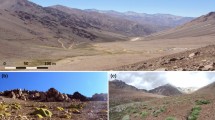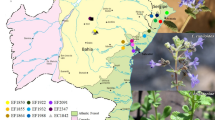Abstract
Repetitive genomic elements were prospected in Campomanesia xanthocarpa, aiming to characterize these elements in a non-model plant species and to develop species-specific microsatellite markers. Approximately 4.12% of the partial genome of C. xanthocarpa is composed of repetitive elements, being retrotransposons the most widely represented. A total of nine polymorphic microsatellite markers were obtained: four nuclear-neutral, two nuclear EST, two plastidial and one mitochondrial. Levels of population genetic diversity of four natural populations of C. xanthocarpa were characterized using these markers. In addition, the cross-species amplification of the microsatellite markers was tested in seven species of tribe Myrteae (Myrtaceae). The characterized microsatellite markers revealed low to moderate levels of genetic diversity (expected heterozygosity range: 0.33–0.57; observed heterozygosity: 0.26–0.74 and number of alleles: 2.25–4.25). Cross-species amplification was successful for all loci, except Cxant76. These nine markers will contribute for studies on genetic diversity, gene flow, plant selection and breeding of this species, towards the conservation of natural populations, as well as its commercial use.

Similar content being viewed by others
References
Barghini E, Natali L, Cossu RM, Giordani T, Pindo M, Cattonaro F, Scalabrin S, Velasco R, Morgante M, Cavallini A (2014) The Peculiar Landscape of Repetitive Sequences in the Olive (Olea europaea L.) Genome. Genome Biol Evol 6:776–791
Doyle JJ, Doyle JL (1990) Isolation of plant DNA from fresh tissue. Focus 12:13–15
Flint-Garcia SA, Thornsberry JM, Buckler ES IV (2003) Structure of linkage disequilibrium in plants. Annu Rev Plant Biol 54:357–374
Góes BD, Ruas EA, Benício LM, Cassiano D, de Souza FP, Ruas PM (2019) Development and characterization of microsatellite loci for Campomanesia xanthocarpa (Myrtaceae) and cross amplification in related species. Acta Scientiarum. Biol Sci 41:e43454
Goudet J (2001) FSTAT: a program to estimate and test gene diversities and fixation indices (Version 2.9.3.2). University of Lausanne, Switzerland
Guzman F, Almerão MP, Körbes AP, Loss-Morais G, Margis R (2012) Identification of MicroRNAs from Eugenia uniflora by High-Throughput Sequencing and Bioinformatics Analysis. PLoS One 7(11):e49811
Guzman F, Kulcheski FR, Turchetto-Zolet AC, Margis R (2014) De novo assembly of Eugenia uniflora L. transcriptome and identification of genes from the terpenoid biosynthesis pathway. Plant Sci 229:238–246
Kalendar R, Grob T, Suoniemi A, Schulman AH (1999) IRAP and REMAP: Two new retrotransposon-based DNA fingerprinting techniques. Theor Appl Genet 98:704–711
Kalinowski ST, Taper ML, Marshall TC (2007) Revising how the computer program CERVUS accommodates genotyping error increases success in paternity assignment. Mol Ecol 16:1099–1106
Khodwekar S, Staton M, Coggeshall MV, Carlson JE, Gailing O (2015) Nuclear microsatellite markers for population genetic studies in sugar maple (Acer saccharum Marsh.). Annu For Res 58:193–204
Klabunde GHF, Olkoski D, Vilperte V, Zucchi MI, Nodari RO (2014) Characterization of 10 new Nuclear Microsatellite Markers in Acca sellowiana (Myrtaceae). Appl Plant Sci 2:1400020
Legrand CD, Klein RM (1977) Mirtáceas. In: Reitz R (ed) Flora ilustrada catarinense. Herbário Barbosa Rodrigues, Itajaí, pp 596–602
Lemos RPM, Matielo CBDO, Beise DC, Rosa VG, Sarzi DS, Roesch LFW, Stefenon VM (2018) Characterization of plastidial and nuclear SSR markers for understanding invasion histories and genetic diversity of Schinus molle L. Biology 7:43
Lisbôa GN, Kinupp VF, Barros IBI (2011) Campomanesia xanthocarpa (Guabiroba). In: Coradin L, Siminski A, Reis A (eds) Espécies nativas da flora brasileira de valor econômico atual ou potencial: plantas para o futuro: Região Sul. MMA, Brasília, pp 159–162
Macas J, Neumann P, Navrátilová A (2007) Repetitive DNA in the pea (Pisum sativum L.) genome: comprehensive characterization using 454 sequencing and comparison to soybean and Medicago truncatula. BMC Genom 8(1):1471–2164. https://doi.org/10.1186/1471-2164-8-427
Macas J, Novák P, Pellicer J, Čížkov J, Koblížkov A, Neumann P, Fukov I, Doležel J, Kelly LJ, Leitch IJ (2015) In depth characterization of repetitive DNA in 23 plant genomes reveals sources of genome size variation in the legume tribe fabeae. PLoS One 10:e0143424
Machado LO (2017) Análise comparativa do genoma plastidial de Myrtaceae: Acca sellowiana (O. Berg) Burret, Eugenia uniflora L., Campomanesia xanthocarpa (Mart.) O.Berg, Plinia cauliflora (Mart.) Kausel, Plinia aureana (Mattos) Mattos e Plinia sp [Comparative analysis of the plastid genome of Myrtaceae: Acca sellowiana (O. Berg) Burret, Eugenia uniflora L., Campomanesia xanthocarpa (Mart.) O.Berg, Plinia cauliflora (Mart.) Kausel, Plinia aureana (Mattos) Mattos and Plinia sp]. Dissertation, Federal University of Santa Catarina
Marcon HS, Domingues DS, Silva JC, Borges RJ, Matioli FF, Fontes MRM, Marino CL (2015) Transcriptionally active LTR retrotransposons in Eucalyptus genus are differentially expressed and insertionally polymorphic. BMC Plant Biol 15:198. https://doi.org/10.1186/s12870-015-0550-1
Mehrotra S, Goyal V (2014) Repetitive sequences in plant nuclear DNA: types, distribution, evolution and function. Genom Proteom Bioinf 12:164–171
Nagel JC, Ceconi DE, Poletto I, Stefenon VM (2015) Historical Gene Flow within and among Populations of Luehea divaricata in the Brazilian Pampa. Genetica 143:317–329
Owusu SA, Staton M, Jennings TN, Schlarbaum S, Coggeshall MV, Romero-Severson J, Carlson JE (2013) Gailing O (2013) development of genomic microsatellites in Gleditsia triacanthos (Fabaceae) using illumina sequencing. Appl Plant Sci 1:1300050
Peakall R, Smouse PE (2012) GenAlEx 6.5: genetic analysis in Excel. Population genetic software for teaching and research—an update. Bioinformatics 28:2537–2539
Petit RJ, Duminil J, Fineschi S, Hampe A, Salvini D, Vendramin GG (2005a) Comparative organization of chloroplast, mitochondrial and nuclear diversity in plant populations. Mol Ecol 14:689–701
Petit RJ, Duminil J, Fineschi S, Hampe A, Slavini D, Vendramin GG (2005b) Comparative organization of chloroplast, mitochondrial and nuclear diversity in plant populations. Mol Ecol 14:689–701. https://doi.org/10.1111/j.1365-294X.2004.02410.x
Raymond M, Rousset F (1995) GENEPOP (Version 1.2): population genetics software for exact tests and ecumenicism. J Hered 86:248–249
Rousset F (2008) Genepop’007: a complete re-implementation of the genepop software for windows and linux. Mol Ecol Resour 8:103–106
Rozen S, Skaletsky HJ (2000) Primer3 on the WWW for general users and for biologist programmers. In: Krawetz S, Misener S (eds) Bioinformatics methods and protocols: methods in molecular biology. Humana Press, Totowa, pp 365–386
Santos KL, Santos MO, Laborda PR, Souza AP, Peroni N, Nodari RO (2008) Isolation and characterization of microsatellite markers in Acca sellowiana (Berg) Burret. Molecular Ecology Resources 8:998–1000
Sarzi DS, Justolin B, Silva C, Lemos RPM, Stefenon VM (2019) Discovery and characterization of SSR markers in Eugenia uniflora L. (Myrtaceae) using low coverage genome sequencing. An Acad Bras Ciênc 91:20180420
Shcherban AB (2015) Repetitive DNA sequences in plant genomes. Russ J Genet Appl Res 5:159–167. https://doi.org/10.1134/S2079059715030168
Staton M, Best T, Khodwekar S, Owusu S, Xu T, Xu Y, Jennings T, Cronn R, Arumuganathan AK, Coggeshall M et al (2015) Preliminary genomic characterization of ten hardwood tree species from multiplexed low coverage whole genome sequencing. PLoS ONE 10:e0145031
Stefenon VM, Nagel JC, Poletto I (2016) Evidences of genetic bottleneck and fitness decline in Luehea divaricata populations from Southern Brazil. Silvae Fennica 50:1566
Stefenon VM, Sarzi DS, Roesch LFW (2019) High-throughput sequencing analysis of Eugenia uniflora: insights into repetitive DNA, gene content and potential biotechnological applications. 3 Biotech 9:200. https://doi.org/10.1007/s13205-019-1729-1
Thiel T, Michalek W, Varshney R, Graner A (2003) Exploiting EST databases for the development and characterization of gene-derived SSR-markers in barley (Hordeum vulgare L.). Theor Appl Genet 106:411–422
Van Oosterhout C, Hutchinson WF, Wills DPM, Shipley P (2004) MICRO-CHECKER: software for identifying and correcting genotyping errors in microsatellite data, version 2.2.4. Mol Ecol Notes 4:535–553
Viecili PRN, Borges DO, Kirsten K, Malheiros J, Viecili E, Melo RD, Trevisan G, Silva MA, Bochi GV, Moresco RN, Klafke JZ (2014) Effects of Campomanesia xanthocarpa on inflammatory processes, oxidative stress, endothelial dysfunction and lipid biomarkers in hypercholesterolemic individuals. Atherosclerosis 234:85–92
Vieira MLC, Santini L, Diniz AL, Munhoz CF (2016) Microsatellite markers: what they mean and why they are so useful. Genet Mol Biol 39(3):312–328
Wu Y, Zhang R, Staton M, Schlarbaum SE, Coggeshall MV, Romero-Severson J, Carlson JE, Liang H, Xu Y, Drautz-Moses DI et al (2017) Development of genic and genomic microsatellites in Gleditsia triacanthos L (Fabaceae) using illumina sequencing. Ann For Res 60(2):343–350
Acknowledgements
The authors would like to thank Conselho Nacional de Desenvolvimento Científico e Tecnológico (CNPq) for the financial support (Proc. 307144/2013-5) and scholarships and grants awarded to V.M.S. (Process 113617/2018-6), V.S.P. and R.O.N. The authors would also like to thank CAPES for scholarships awarded to G.H.F.K. and L.O.M., and to the Nucleus of Nitrogen Fixation/UFPR for sequencing. We thank Ms. Yohan Fritsche (LFDGV, UFSC) for the help with the flow cytometry analysis.
Author information
Authors and Affiliations
Corresponding author
Ethics declarations
Ethical approval
This article does not include any studies with human participants or animals performed by any of the authors.
Informed consent
This article does not involve any informed consent.
Conflict of interest
All authors hereby declare that there is no conflict of interest.
Electronic supplementary material
Below is the link to the electronic supplementary material.
Rights and permissions
About this article
Cite this article
Petry, V.S., Stefenon, V.M., Machado, L.O. et al. Repetitive genomic elements in Campomanesia xanthocarpa: prospection, characterization and cross amplification of molecular markers. 3 Biotech 9, 423 (2019). https://doi.org/10.1007/s13205-019-1953-8
Received:
Accepted:
Published:
DOI: https://doi.org/10.1007/s13205-019-1953-8




